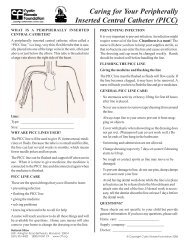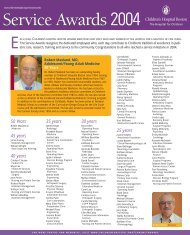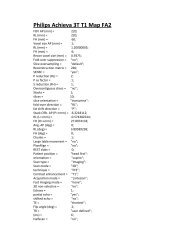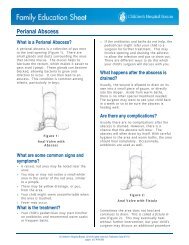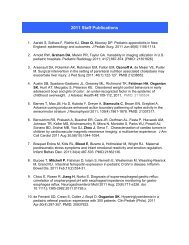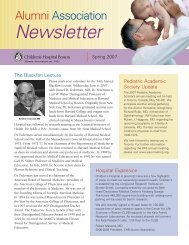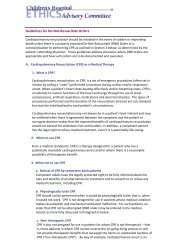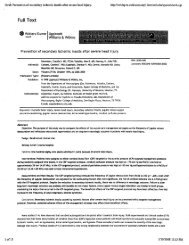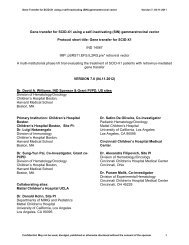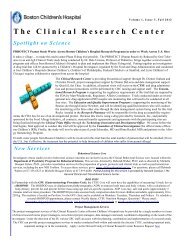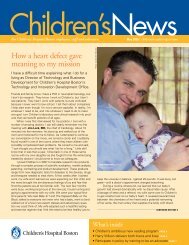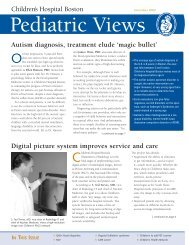Download PINS 2011 instruction manual - Children's Hospital Boston
Download PINS 2011 instruction manual - Children's Hospital Boston
Download PINS 2011 instruction manual - Children's Hospital Boston
Create successful ePaper yourself
Turn your PDF publications into a flip-book with our unique Google optimized e-Paper software.
Instruction Manual<br />
Pediatric International Nutrition<br />
Survey <strong>2011</strong>
Table of Contents<br />
Table of Contents.................................................................................................................................................... 2<br />
Study Contacts ........................................................................................................................................................ 2<br />
Introduction .............................................................................................................................................................. 3<br />
General Guidelines................................................................................................................................................. 4<br />
Pediatric Critical Care Nutrition Website ............................................................................................................. 6<br />
Survey Login Page and Registration ................................................................................................................... 7<br />
Home Page............................................................................................................................................................ 10<br />
Patient Status Page.............................................................................................................................................. 13<br />
Screening ............................................................................................................................................................... 15<br />
Patient Information Form ..................................................................................................................................... 18<br />
Baseline Nutrition Assessment Form................................................................................................................. 20<br />
Daily Nutrition Data............................................................................................................................................... 22<br />
Enteral Nutrition Data........................................................................................................................................... 23<br />
Parenteral Nutrition Data ..................................................................................................................................... 26<br />
Patient Outcome ................................................................................................................................................... 28<br />
Finalizing Data Entry ............................................................................................................................................ 30<br />
Appendix 1 - PICU Admission Taxonomy ......................................................................................................... 31<br />
Appendix 2 – Enteral Formula Taxonomy......................................................................................................... 37<br />
� Principal Investigator<br />
5/5/<strong>2011</strong><br />
Study Contacts<br />
Nilesh M. Mehta, MD, DCH<br />
Assistant Professor, Department of Anesthesia, Perioperative and Pain Medicine<br />
Division of Critical Care Medicine<br />
<strong>Children's</strong> <strong>Hospital</strong> <strong>Boston</strong><br />
Email: nilesh.mehta@childrens.harvard.edu<br />
Tel: 617-355-7327<br />
� Project Leader<br />
Lori Bechard, M.Ed., R.D., LDN<br />
Clinical Nutrition Specialist III<br />
Clinical Nutrition Service<br />
Children’s <strong>Hospital</strong> <strong>Boston</strong><br />
Email: lori.bechard@childrens.harvard.edu<br />
Tel: 617 355 5293<br />
2
5/5/<strong>2011</strong><br />
Introduction<br />
Pediatric International Nutrition Survey (<strong>PINS</strong> <strong>2011</strong>)<br />
This project is a period-prevalence survey of nutrition therapies in critically ill children in<br />
pediatric intensive care units (PICUs) across the world. This survey will commence on 11 May<br />
<strong>2011</strong>, or the nearest date practically possible.<br />
Dietitians (or other healthcare practitioners) at each PICU will record data including site<br />
characteristics, patient demographics and nutrition goals, illness severity, length of stay,<br />
duration of ventilation, infectious outcomes, and mortality. In addition, daily nutrition practices<br />
such as route of nutrition, energy and protein amounts received, feeding interruptions, and<br />
related medications will also be recorded from PICU admission to PICU discharge, death, or<br />
for a maximum of 10 days (whichever comes first).<br />
It is projected that the results of this survey will identify differences, highlight strengths and<br />
weaknesses, and hopefully illuminate opportunities to improve nutrition practices in the United<br />
States and throughout the world.<br />
Benchmarked Site Report<br />
For participating in this project, you will be provided with a benchmarked site report. This<br />
site report summarizes your site’s performance and will allow you to compare your nutrition<br />
practices to other PICUs within your own country or region (‘Sister Sites’) and all the PICUs in<br />
the database (‘All Sites’). You will also be able to compare your performance to the<br />
recommendations of the ASPEN Clinical Guidelines for Nutrition Support of the Critically Ill<br />
Child.<br />
Instruction Manual<br />
This Instruction Manual functions as a resource for successful completion of the electronic<br />
case report forms (eCRFs) for <strong>PINS</strong> <strong>2011</strong>.<br />
The <strong>manual</strong> is formatted to provide <strong>instruction</strong> for each eCRF data page. An image of the<br />
actual data page will follow the written <strong>instruction</strong>s.<br />
eCRFs are the exclusive mode of data capture used in <strong>PINS</strong> <strong>2011</strong>. The dietitian (or other<br />
healthcare practitioner) should enter data online to the eCRFs as soon as it becomes<br />
available.<br />
NOTE: If you choose to create paper worksheets, please keep ALL documents until you receive your<br />
benchmarked performance report. This will provide you with an opportunity to check your site report<br />
with the raw data and ensure that it is accurate.<br />
Please check with your hospital for local requirements regarding storage of data collection forms as this<br />
may differ by hospital site.<br />
Please contact the Project Leader for any questions or clarification about <strong>PINS</strong> <strong>2011</strong>.<br />
3
5/5/<strong>2011</strong><br />
General Guidelines<br />
Ethics<br />
We have received ethics approval from Children’s <strong>Hospital</strong> <strong>Boston</strong> to conduct this survey and<br />
to publish the results. You must contact your local ethics committee to obtain local approval<br />
or a waiver for this requirement. For more information, please contact the Project Leader.<br />
Accessing the Website<br />
Approval or waiver from your local IRB/ethics committee at your site is required before you<br />
can register for access to the data entry tool. Please forward a copy of the approval<br />
documentation to the Project Leader. We will provide a username and password only to<br />
individuals who have registered to participate in <strong>PINS</strong> <strong>2011</strong>, and for those designated by<br />
these registrants. To register, go to the login page at https://ceru.hpcvl.queensu.ca/CCN_P<br />
and click on the 'Create new login account' link. Complete the form (including choosing your<br />
own password) and click Save. You will then get a message instructing you to contact our IT<br />
specialist. Please provide him with the email used in the registration process, the name of the<br />
hospital and if you are the primary investigator. You will then receive a unique username<br />
from him, allowing you to access the web-based tool with the password you specified.<br />
The web based tool for <strong>PINS</strong> <strong>2011</strong> can be accessed by following the link to this website<br />
https://ceru.hpcvl.queensu.ca/CCN_P or through the <strong>Children's</strong> <strong>Hospital</strong>, <strong>Boston</strong> website<br />
http://www.childrenshospital.org/PCCN<br />
� All users must log onto the website using their own username and password prior to data<br />
entry.<br />
� When you log in, you will be taken to the appropriate page based on the PICU(s) that you<br />
have access to. If you are registered for more than one PICU, you will be taken to the ‘My<br />
ICUs’ page. If you are registered for a single PICU, you will be taken to the appropriate<br />
ICU status page.<br />
� Your user profile and password can be changed at any time by clicking the appropriate<br />
links on the Pediatric International Nutrition Survey home page.<br />
Completion of eCRFs<br />
� All data collection activities will be completed in the web based tool.<br />
� Only patients meeting the inclusion criteria should be entered on the web (see<br />
Screening, page 15).<br />
� Enter all times using the 24-hour period format i.e. 22:37. To ensure a proper time format<br />
the web system will automatically enter a colon for you or you can <strong>manual</strong>ly enter a colon<br />
or semi-colon.<br />
� To access eCRFs single click the appropriate link using the left side of your mouse.<br />
� Most data fields only support numerical data and will not recognize a unit suffix (e.g. Kg,<br />
Kcal, mmol). Enter all data without units. All units are displayed next to the appropriate<br />
data field. Please enter the data with the units as labeled in the data tool. All<br />
kilocalorie and protein data is entered in total per day, NOT per kg.<br />
� To expand a menu or taxonomy click on ‘+’ next to the title of the menu/taxonomy. To<br />
collapse the menu or taxonomy click on ‘-‘.<br />
� The RESET form button will take you back to the last saved version.<br />
� The EXIT form button will take you back to the ICU or Patient Status page.<br />
4
� Please follow the order in which the forms appear. This will reduce the ‘outstanding<br />
issues’.<br />
All data fields MUST be completed. The web based data entry system has been programmed with various<br />
range checks to simplify the query process. In the event that you leave a data field blank or the values that you<br />
have entered are beyond web ranges, you will receive an input warning either directly on the form or under<br />
‘Outstanding Issues’ on the Patient Status page. Please follow the <strong>instruction</strong>s on the screen to “view/edit” the<br />
data and resolve the query.<br />
Editing data entered in the web-based tool<br />
� To edit previously saved information, access the appropriate eCRF, change the<br />
appropriate field(s), and re-save the form. All entries are tracked and logged by the<br />
computer program.<br />
� You cannot delete patients.<br />
� Please contact the Project Leader if you have any questions about editing or deleting data.<br />
Duration of Data Collection<br />
Study Day 1 is from PICU admission to the end of your PICU’s 24 hr flowsheet.<br />
Study Day 2 and subsequent days start at the time the PICU chart starts until it ends 24 hours later (e.g. from<br />
07:59 on 10 May 11 until 08:00 on 12 May 11).<br />
� All daily nutrition data is recorded from PICU admission (Study day 1) and each day<br />
following until day 10 unless PICU discharge (actual) or death occurs before day 10.<br />
� If a patient is re-admitted to your PICU within 48 hrs of discharge, consider this to be a<br />
continuation of the previous stay. If a patient is re-admitted to your PICU after 48 hours of<br />
discharge, this is not considered to be a continuation of the previous stay and patient<br />
cannot be included in the survey again.<br />
� The eCRFs may be completed retrospectively but it is recommended for data to be<br />
entered as soon as possible after it is collected.<br />
Finalizing Patients and Data Completion<br />
The web based data tool has been programmed to recognize when the patient is eligible for<br />
finalization (i.e. no outstanding issues and a minimum of three days data entered). At this<br />
point, you will be able to access and complete the Patient Outcome page. Once the Patient<br />
Outcome page is completed, the patient’s status will change to ‘Finalized’.<br />
When at least 15 patients (or more, depending on your recruitment rate) have been finalized,<br />
navigate back to the ICU Status page and check the box that asks ‘Is data entry finalized at<br />
your PICU?’<br />
Please collect data on at least 15 but no more than 40 patients.<br />
5/5/<strong>2011</strong><br />
5
5/5/<strong>2011</strong><br />
Pediatric Critical Care Nutrition Website<br />
The Pediatric Critical Care Nutrition website will be the gateway for accessing the web<br />
application’s login page. Go to our website at http://www.childrenshospital.org/PCCN and<br />
click on ‘2nd International Study of Nutrition Therapy in the PICU’, or access the login site<br />
directly at https://ceru.hpcvl.queensu.ca/CCN_P/.<br />
Updates and useful information regarding the Pediatric International Nutrition Survey will also<br />
be posted on this website so please check it regularly.<br />
6
5/5/<strong>2011</strong><br />
Survey Login Page and Registration<br />
Site Registration<br />
Prior to entering data for your PICU, you will first need to create a site/user account. This only<br />
needs to be completed once. Although several individuals can have access and enter data for<br />
your PICU site, the individual coordinating the survey at your PICU site should take<br />
responsibility for this initial registration process.<br />
User Registration<br />
To register, go to the login page and click on the 'Create new login account' link. Complete<br />
the form (including choosing your own password) and hit save. The password is case<br />
sensitive and must be at least 6 characters long. Do not type spaces between characters and<br />
do not use repeating characters. You will then get a message instructing you to contact our IT<br />
specialist. Please provide him with the email used in the registration process, the name of<br />
your hospital, and if you are the primary investigator. You will then receive a unique<br />
username from him, allowing you to access the web-based tool with the password you<br />
specified. Please be aware that your username will be sent to you by e-mail shortly after you<br />
register (or after you are granted permissions). Since the source of the e-mail may not be<br />
recognized by your provider, please check your junk mail folder in the event that the survey email<br />
is diverted there.<br />
PICU Registration<br />
� Go to the survey login page and enter your username and password.<br />
� You will be asked to complete questions about your hospital and PICU.<br />
� Click on ‘Save ICU’.<br />
� You will be directed to the ICU status page and can begin to enter patient data.<br />
� If you wish to register more than one PICU, on the ICU status page, click on ‘Register<br />
New ICU’.<br />
� You can edit your user profile and hospital/PICU details or change your password at<br />
any time by following the appropriate links.<br />
Grant Permission to Other Users<br />
� If you wish to grant permission for other users, on the ICU status page, click on ‘grant<br />
permissions for this ICU to other users’, enter their e-mail addresses and click on<br />
‘grant permissions’. This will generate an e-mail to new users with a username and<br />
temporary password to access the survey.<br />
7
� Consent to participate: Checking this box tells us that you have read the information about the study<br />
and understand its purpose. It will allow us to compute benchmarked site reports comparing your<br />
performance with other PICUs in the dataset. All data will be aggregated, so that individual patients will<br />
not be identifiable and other sites will not be able to identify your PICU. Consenting to participate also<br />
allows us to correctly acknowledge your participation on the website and in other publications.<br />
� Forget your Password?: If you forget your password, click on the ‘forget your password?’ tab on the<br />
login page. Enter your e-mail address and complete the human user verification. You will be sent an email<br />
with your username and a temporary password. Please change your password when you next login<br />
to the survey.<br />
� Human User Verification: You must type the letters or numbers you see in the box to confirm that a<br />
person is trying to access the survey and not an automated program. This helps to prevent automated<br />
programs from misusing the survey.<br />
� PICU Registration: Although you may be aware of the answers to these questions, please confirm the<br />
type of PICU and case mix details with the medical or nursing director of your PICU.<br />
� Multiple PICUs: If your hospital has multiple PICUs, please enter YES when prompted, and enter your<br />
PICU name. Make sure that you select a name for your PICU that is distinct from the other PICUs in your<br />
hospital (e.g. medical, surgical, cardiac)<br />
� Type of <strong>Hospital</strong>: A teaching hospital is a hospital that provides training to medical students and<br />
residents. If your hospital only has occasional medical students/residents, record your hospital as a nonteaching<br />
hospital.<br />
� PICU Structure: Open ICUs are sites where patients are under the care of an attending physician (e.g.<br />
internist, family physician, surgeon) with intensivists (i.e. physician with training in critical care) consulted<br />
as necessary. Closed ICUs are sites in which patients are under the care of an intensivist, or care is<br />
shared between the intensivist and another attending physician.<br />
� Full Time Equivalent (FTE) Dietitian: This is a measure of the amount of time the dietitian is dedicated<br />
to the PICU relative to a full-time position e.g. a FTE of 1.0 means that the dietitian works in the PICU fulltime<br />
and a FTE of 0.5 means that the dietitian is in the PICU half-time, or two and a half days a week.<br />
5/5/<strong>2011</strong><br />
8
5/5/<strong>2011</strong><br />
Login Page<br />
9
5/5/<strong>2011</strong><br />
Home Page<br />
My ICUs<br />
� This will be your ‘home’ page if you are registered for more than one PICU.<br />
� This page will display a list of PICUs for which you have been granted permission to enter<br />
data. The list will include the name of the PICU, the number of patients registered, and<br />
the number of patients finalized.<br />
� Clicking on a specific PICU will take you to the ‘ICU Status’ page for that PICU.<br />
� You can enter the ‘My ICUs’ page at any time by clicking on the appropriate links on the<br />
menu.<br />
ICU Status Page<br />
� This will be your ‘home’ page if you are registered for a single PICU.<br />
� This page displays a list of all the patients registered at your PICU. The list includes the<br />
patient number, basic demographic data, and the patient’s status. The statuses are:<br />
o In progress: The patient has less than three days of data entered, and/or<br />
there are outstanding queries. The patient is therefore not eligible for<br />
finalization.<br />
o Eligible for finalization: The patient has no outstanding queries and has a<br />
minimum of three days of data entered, and is therefore eligible for finalization.<br />
o Finalized: Data entry, including outcomes, is complete, with no outstanding<br />
queries.<br />
� Click on the line containing details about a specific patient to navigate to the Patient<br />
Status page for that patient.<br />
Menu Tabs<br />
� My ICUs. To view a summary of all your registered PICUs and the number of patients<br />
registered and finalized in each one, click on the ‘My ICUs’ left hand menu.<br />
� ICU Status. To view a summary of the number of patients registered at a single PICU<br />
and the number of patients finalized click on the ‘ICU Status’ left hand menu.<br />
� Register New Patient. To register a new patient, click on ‘register new patient’ on the<br />
left hand side menu.<br />
� Edit User Profile. To change your personal information click on ‘edit user profile’ on<br />
the left hand side menu<br />
� Change password. To change password, click on ‘change password’ on the left hand<br />
side menu. You will be asked to enter your old password, select and confirm a new<br />
password.<br />
� Contact Us. On the left hand side of the menu click on ‘contact us’ to view the contact<br />
details for the Project Leader and Technical Support.<br />
� Help. To access information related to the study and Pediatric Critical Care Nutrition,<br />
click on ‘help’ on the left hand side menu.<br />
10
� Log Out. To log out of the web system and return to the login page click on “Log out’<br />
on the left hand side menu.<br />
5/5/<strong>2011</strong><br />
‘My ICUs’ Page<br />
11
5/5/<strong>2011</strong><br />
‘ICU Status’ Page<br />
12
5/5/<strong>2011</strong><br />
Patient Status Page<br />
� After clicking on a specific patient on the ICU Status Page you will be directed to the<br />
Patient Status page.<br />
� From this page you can view, enter data, or edit information on all Pediatric<br />
International Nutrition Survey eCRFs.<br />
� If you ‘save’ any eCRF, you will be directed back to this page.<br />
� To enter, review or edit daily nutrition data, click on the row corresponding to the study<br />
day, or click on “new observation” to add a new study day.<br />
� To enter, review or edit Enteral Nutrition (EN) or Parenteral Nutrition (PN) data, click<br />
on ‘Yes’ in the respective column(s).<br />
� When all PICU study days have been entered (minimum 3 days), select ‘Finalize<br />
Patient’. You will be directed to the Patient Outcome page.<br />
13
5/5/<strong>2011</strong><br />
Patient Status Page<br />
14
5/5/<strong>2011</strong><br />
Screening<br />
Please begin to identify study patients on 11 May <strong>2011</strong> (or nearest possible date<br />
thereafter).<br />
� The Screening Log is not part of the online data collection process, but has been<br />
developed as a tool to help you to identify which patients in the PICU meet the<br />
inclusion criteria. We will not ask you to enter any information from this form online.<br />
Eligibility Criteria<br />
Inclusion:<br />
� Critically ill patients that are mechanically ventilated and have an anticipated stay of ><br />
48 hours in the PICU.<br />
� Children ages 1 month to 18 years.<br />
Exclusion:<br />
� Patients who were not ventilated within the first 48 hours of admission.<br />
� Patients on mask ventilation.<br />
� Patients on compassionate care towards end-of-life.<br />
� Patients enrolled in any other nutritional interventional trial.<br />
Duration of Ventilation does not matter. Patients that were ventilated within the first 48 hours of admission<br />
to the PICU, and then came off the ventilator and stay in the PICU > 3 days, still meet the eligibility criteria.<br />
If the patient is ventilated prior to admission to the PICU they meet the eligibility criteria.<br />
To identify your eligible study patients using the Screening Log, complete the following steps:<br />
� Record the initials of ALL patients that are currently in your PICU in Column 1<br />
� In Column 2, record only those patients from Column 1 that were intubated and ventilated<br />
within the first 48 hrs of admission to PICU or prior to PICU admission.<br />
� In Column 3, list only those patients from Column 2 that were in PICU � 3 days.<br />
� In Column 4, number the patients from Column 3 consecutively and these are your eligible<br />
study patients.<br />
� In Column 5, enter the identification number the patient was allocated by the web-based<br />
tool.<br />
� Continue to screen until you reach a minimum of 15, maximum of 40 consecutive patients.<br />
� For patients that are just admitted and are ventilated, please follow them up for 72 hours to<br />
see if they stay in the ICU � 3 days, as they will also be included.<br />
� Please keep the Screening Log to help track down which patient corresponds to which<br />
patient number in case we have data queries at a later date.<br />
15
SCREENING LOG PICU Name<br />
This log is for your own reference and will not be entered online.<br />
Column 1 Column 2 Column 3 Column 4 Column 5<br />
Initials for ALL patients<br />
in the PICU on<br />
beginning study day<br />
5/5/<strong>2011</strong><br />
Patients intubated and<br />
ventilated within the first 48<br />
hrs of admission to PICU<br />
Patients in the PICU �<br />
3 days<br />
Screening Number Patient ID<br />
Number<br />
Total number of patients meeting inclusion criteria =____________<br />
16
Screening Notes:<br />
� If the number of patients meeting inclusion criteria is less than 20, please continue to<br />
screen daily until you have a minimum of 15 CONSECUTIVE patients (maximum<br />
accrual 40 patients).<br />
� Consecutive: means the very next patient that meets the criteria, instead of picking<br />
and choosing patients randomly.<br />
� For those patients just admitted and are ventilated, please follow them up for 72 hours<br />
to see if they stay in the PICU (� 3 days) as they will also be included into your study<br />
cohort.<br />
� Include the patient if he/she is physically in the PICU at time of screening and meets<br />
the criteria even if they are ready for discharge from the PICU and are waiting for a<br />
bed on the ward.<br />
� If the patient has had several admissions to the PICU, use the most recent admission.<br />
� If a patient is discharged from the PICU but re-admitted within 48 hours, consider that<br />
this patient never left the PICU.<br />
� If data are missing and you are unable to collect the relevant details for this patient,<br />
please exclude and include the next eligible consecutive patient.<br />
� The screening number and patient number (generated by the web based data tool) will<br />
be the same if you enter the patients in consecutive order.<br />
5/5/<strong>2011</strong><br />
17
5/5/<strong>2011</strong><br />
Patient Information Form<br />
This eCRF is to be filled out once for each patient.<br />
Demographics: Enter the gender and age of the patient with the appropriate units (years,<br />
months, days).<br />
Admission Information: If mechanical ventilation was initiated prior to PICU admission (e.g.<br />
patient transferred from another PICU), check the box that says ‘ventilation initiated prior to<br />
ICU admission’.<br />
Admission Category: Choose the most suitable admission category. If surgical indicate if<br />
this is elective or emergency surgery.<br />
Admission Diagnosis: View the PICU Admission Taxonomy provided (see Appendix 1).<br />
This is the diagnosis that resulted in the patient’s admission to PICU. If the Admission<br />
Diagnosis is not present in the taxonomy, look for the appropriate condition (based on<br />
admission category) and choose “Other” and type in the diagnosis in the box below. For<br />
example, if Admission Diagnosis is Cystic Fibrosis, choose “Other respiratory disease (#20)”<br />
and type in “Cystic Fibrosis”.<br />
Presence of Acute Respiratory Distress Syndrome (ARDS): ARDS is an acute lung<br />
condition characterized by PaO2:FiO2 < 200 in the presence of bilateral alveolar infiltrates<br />
on chest x-ray. You are not expected to diagnose ARDS. You only need to review the chart<br />
for the first 72 hrs from admission to the PICU for either a confirmed or suspected diagnosis of<br />
ARDS. If the chart says “? ARDS”, this is suspected ARDS, enter Yes.<br />
Severity of Illness score - Pediatric Risk of Mortality (PRISM) or Pediatric Index of<br />
Mortality (PIM): Enter whatever score is calculated by your PICU. If presently unavailable,<br />
leave field blank and complete at a later date. Please specify the score used, PRISM 2,<br />
PRISM 3, or PIM. This field is required for data finalization.<br />
18
5/5/<strong>2011</strong><br />
Patient Information Form<br />
19
5/5/<strong>2011</strong><br />
Baseline Nutrition Assessment Form<br />
This eCRF is to be filled out once for each patient.<br />
� Record height in centimeters and weight in kilograms at time of PICU admission. If<br />
unable to obtain “actual” height or weight, use estimated height and weight or that<br />
obtained from family members and check the appropriate box to indicate that data was<br />
estimated. Use “dry weight” (i.e. weight in the absence of fluid overload) if fluid retention is<br />
present.<br />
� For weight used to determine prescribed energy requirements, choose from the drop-down<br />
list:<br />
1 Actual (ABW)<br />
2 IBW based on growth chart<br />
3 Adjusted by 25% (ABW x 0.25 + IBW)<br />
4 Adjusted by 40% (ABW x 0.4 + IBW)<br />
5 Adjusted average (ABW + IBW) x 0.5<br />
6 No weight used in calculation<br />
7 No assessment completed<br />
8 Other, please specify<br />
� For determination of basal energy requirements choose from the drop-down list:<br />
1 Harris Benedict equation<br />
2 Schofield equation<br />
3 WHO<br />
4 White<br />
5 Talbot<br />
6 Indirect calorimetry<br />
7 Other, please specify<br />
� Enter stress factor applied to the chosen equation in numeric form (i.e. enter ‘1.5’ for 150%<br />
of estimated BEE)<br />
� For Targeted Energy Goal, enter the total kilocalories per day to be provided by the goal<br />
regimen for EN/PN, according to the dietitian’s or physician’s assessment.<br />
� For Targeted Protein Goal, enter the total grams of protein per day to be provided by the<br />
goal regimen for EN/PN, according to the dietitian’s or physician’s assessment.<br />
� e.g., If the dietitian recommends a starting rate of 5 ml/hr on day 1 with a final<br />
rate of 45 ml/hr by day 3, enter the total daily calories and protein that the final<br />
rate = 45ml/hr X 24 hrs. will provide, in kilocalories per day and grams of<br />
protein per day (NOT per kg).<br />
20
5/5/<strong>2011</strong><br />
� For those receiving both EN and PN, please record the total kilocalories and<br />
grams of protein per day to be provided from the combined prescription of EN<br />
and PN.<br />
Baseline Nutrition Assessment Form<br />
21
Daily Nutrition Data<br />
This eCRF is to be filled out for each patient daily. The study day will automatically appear on<br />
the screen.<br />
Study Day 1 is from ICU admission time to the end of your 24 hr flowsheet.<br />
Study Day 2 and subsequent days start at the time the ICU chart starts until it ends 24 hours later. (e.g.<br />
from 08:00 on 11 May 11 until 07:59 on the 12 May 11)<br />
� For each study day, indicate “Yes” or “No” to indicate all types of nutrition patient<br />
received.<br />
� If patient is on both EN and PN on the same day, click the ‘yes’ response in both<br />
places (“Enteral nutrition” and “Parenteral nutrition”).<br />
� Click on ‘save’ to save the form and return to the patient status page.<br />
� EN and PN pages are accessed from the patient status page. If you have selected<br />
EN or PN in the daily nutrition data, “Yes” will appear in the EN or PN column for<br />
that study day. Click on “Yes” in the appropriate column to be directed to the EN or<br />
PN page corresponding with that study day.<br />
� If you accidentally enter an extra or incorrect study day, please contact<br />
Technical Support stating your username, the patient number and the patient<br />
day that you wish to delete.<br />
5/5/<strong>2011</strong><br />
Daily Nutrition Data Page<br />
22
5/5/<strong>2011</strong><br />
Enteral Nutrition Data<br />
� Complete this eCRF for each patient daily. The study day will automatically appear.<br />
� EN Formula: Using the taxonomy provided (see Appendix 2), please record the<br />
enteral formula(s) received.<br />
o You may select up to 3 formulas per day. In the event that the patient receives<br />
more than 3 formulas, select the 3 that provided the largest volumes.<br />
o On subsequent days, answer yes or no to the question “Has the EN formula(s)<br />
changed since previous day?”. If you click “Yes” the taxonomy will appear and<br />
you can select new formulas.<br />
� Route for Enteral Nutrition Delivery: Pick one of the gastric or post-pyloric options<br />
from the drop down box to indicate the location of the feeding tube.<br />
o If the location of the feeding tube changes within the day, please choose the<br />
location that was used for the majority of the day. If gastric was used for half<br />
the day and post-pyloric for the other half, choose post-pyloric.<br />
� Kilocalories Received: The total enteral calories received each day (NOT per kg)<br />
should be entered. Include calories from protein, supplements, and modular<br />
components. Do not include calories from IV solutions.<br />
� Protein Received: The total enteral protein grams received each day (NOT per kg)<br />
should be entered. Include protein from additional enteral supplements or modular<br />
components. Do not include protein from PN.<br />
� If patient is on a combination of EN and PN, please calculate the calories and protein<br />
received from each separately and record on the respective EN Data and PN data<br />
pages, without duplication.<br />
� Feeding Interruptions: Indicate Yes or No if enteral nutrition was ever interrupted<br />
today. If yes, enter the total duration of feed interruption (i.e. if the EN feeds were<br />
stopped from 10:00 to 10:45 and then again 13:15 to 20:20 enter 8hrs, 50mins as<br />
‘08:50’). Select the reason that EN feeds were interrupted from the list below. If more<br />
than one reason, hold the ctrl key and click to select multiple reasons.<br />
Code Reason<br />
1 Fasting for endotracheal extubation or intubation<br />
2 Fasting for other bedside procedure<br />
3 Fasting for operating room procedure<br />
4 Fasting for radiology suite procedure<br />
5 Intolerance to enteral feeding – high gastric residuals<br />
6 Intolerance to enteral feeding – increased abdominal girth or abdominal distension<br />
7 Intolerance to enteral feeding – vomiting / emesis or diarrhea<br />
8 Intolerance to enteral feeding –subjective discomfort<br />
9 No enteral access available / enteral access lost, displaced or malfunctioning<br />
10 Inotropes, vasopressor requirement<br />
11 Subject deemed too sick to continue enteral feeding<br />
12 Enteral feeding formula not available<br />
13 Reason for EN interruption not known<br />
23
� Motility Agents: Select the prescribed motility agents from the options below. You do<br />
not need to record the route of administration or the dose. If the patient has been<br />
prescribed combination therapy, please select all motility agents prescribed (hold ctrl<br />
key and click to select multiple options).<br />
5/5/<strong>2011</strong><br />
Code Reason<br />
1 Metoclopramide<br />
2 Motilium<br />
3 Erythromycin<br />
4 Other: Specify______________<br />
5 None<br />
� Antacid usage: Choose from the options listed. You do not need to record the route<br />
of administration or the dose. If the patient has been prescribed combination therapy,<br />
please select all antacids prescribed (hold ctrl key and click to select multiple options).<br />
24
5/5/<strong>2011</strong><br />
Enteral Nutrition Page<br />
25
5/5/<strong>2011</strong><br />
Parenteral Nutrition Data<br />
� Complete this eCRF for each patient daily. The study day will automatically appear.<br />
� Reason EN not provided: Choose from the list, and if the reason for PN is not listed,<br />
select ‘other’ and specify. On subsequent days, answer yes or no to the question “Has<br />
the reason EN not provided changed since the previous day?”. If you click “Yes” the<br />
list will appear and you can select a new reason.<br />
Code Reason<br />
1 No clinical reason<br />
2 Mechanical bowel obstruction<br />
3 Bowel ischemia<br />
4 Small bowel ileus<br />
5 Small bowel fistulae<br />
6 Gastrointestinal perforation<br />
7 Short Gut Syndrome<br />
8 Hemodynamic instability<br />
9 Proximal bowel anastomosis<br />
10 Not tolerating enteral feeding<br />
11 No access to small bowel<br />
12 Pancreatitis<br />
13 Gastrointestinal bleed<br />
14 Gastrointestinal surgery<br />
15 Other: Specify______________<br />
� Total kilocalories received from PN (INCLUDING dextrose, amino acids, NOT<br />
lipids): Parenteral calories received each day (NOT per kg) should be entered.<br />
Include calories from dextrose and amino acids. Do NOT include calories from<br />
lipids. Do not include calories from other IV solutions or propofol.<br />
� Protein Received from PN: The total parenteral protein grams received each day<br />
(NOT per kg) should be entered. Do not include protein from EN. Include protein<br />
from glutamine and parenteral supplements, if applicable.<br />
� Lipids received: Select the type of lipid solution(s) received from the list.<br />
1 Soybean oil based (LCTs)<br />
2 MCT/LCT physical mixture<br />
3 MCT/LCT structured form<br />
4 Olive Oil based<br />
5 Fish Oil based<br />
6 Mixture of soy oil, MCTs, and fish oil<br />
7 Mixture of soy oil, MCTs, olive oil, and fish oil<br />
8 Other<br />
� Parenteral lipid kilocalories received (in kcal/day): The total parenteral lipid<br />
calories received each day (NOT per kg) should be entered. Do not record the<br />
volume administered, just the calorie amount provided from lipids alone.<br />
26
5/5/<strong>2011</strong><br />
Parenteral Nutrition Page<br />
27
5/5/<strong>2011</strong><br />
Patient Outcome<br />
All outstanding issues must be addressed before you can access this page.<br />
Outstanding issues for each patient will appear at the top of their Patient Status Page.<br />
Complete this eCRF once for each patient, after patient is discharged from PICU/hospital or if<br />
the patient dies. Some questions will require you to wait until day 60 following PICU<br />
admission.<br />
� Enteral/Parenteral Nutrition First Initiated: From the list of selections, indicate when<br />
EN and PN were initiated.<br />
Discharge Information<br />
� “Did patient die in hospital/ICU?” Select “Yes” or “No”<br />
o If “Yes”, enter number of days for “length of stay in PICU, in days” and “total<br />
length of hospital stay, in days”<br />
o If “No”, enter number of days for “length of stay in PICU, in days” and “total<br />
length of hospital stay, in days”<br />
o OR, as appropriate, click box next to “Check here if patient still in hospital at<br />
day 60” and “Check here if patient still in PICU at day 60”<br />
� Total number of ventilator days in the PICU (in days)? Indicate total number of<br />
days of mechanical ventilation. If ventilation was discontinued and restarted, count<br />
only the total number of days the patient received mechanical ventilation.<br />
If patient is discharged from PICU while still ventilated (for example, transfer to step-down unit or transfer to<br />
another hospital), days of ventilation are same as ICU days. In addition, please make a comment in the<br />
Comment Box describing the situation.<br />
ICU/hospital discharge, 60 days of hospital stay, OR death marks the end of data collection, whichever comes<br />
first. You do not need to follow-up after hospital discharge or transfer to another healthcare facility.<br />
UTI – Urinary tract infection<br />
VAP – Ventilator associated pneumonia<br />
CRBSI – catheter related blood stream infection<br />
� Presence of VAP/UTI/CRBSI: You are not expected to diagnose these conditions.<br />
Review the chart for the PICU length of stay for either a confirmed or suspected<br />
diagnosis of any of these conditions. If the chart says “? VAP/UTI/CRBSI”, this is<br />
suspected diagnosis, enter Yes.<br />
� If infection was culture proven, please indicate day of PICU admission that<br />
culture was ordered (if presumed infection, leave blank). Enter the day of PICU<br />
admission that the culture was sent, not the day it was discovered positive or treatment<br />
began.<br />
� Click ‘Finalize Patient’ to save the form and be directed back to the patient status<br />
page. If there are outstanding queries, the patient’s status will be listed as ‘in progress’<br />
28
5/5/<strong>2011</strong><br />
on the patient status page. If the patient was finalized successfully, the patient’s status<br />
will be listed as ‘finalized’ on the patient status page.<br />
Patient Outcome Page<br />
29
5/5/<strong>2011</strong><br />
Finalizing Data Entry<br />
To determine when the data entry has been completed, a data finalization process has been<br />
incorporated into the web based data tool.<br />
Make sure that the data you have entered is accurate to the best of your knowledge before<br />
you finalize the data.<br />
When you have completed data entry for a minimum of 15, maximum 40 patients, go to the<br />
ICU Status Page and check the box ‘Is data entry finalized at your ICU?’<br />
THANK YOU for participating in the <strong>2011</strong> Pediatric International Nutrition Survey!<br />
30
Respiratory<br />
� 1. Acute resp. failure<br />
5/5/<strong>2011</strong><br />
Appendix 1 - PICU Admission Taxonomy<br />
� 2. Acute resp fail newborn<br />
� 3. Acute resp. distress, insufficiency<br />
� 4. Pulm respiratory arrest<br />
� 5. Insuff. following surgery& trauma<br />
� 6. Pleural effusion, unspecified.<br />
� 7. Pleural effusion, malignant<br />
� 8. Pleural effusion, streptococcal, staphylococcal, pneumococcal.<br />
� 9. Asthma, w/o status<br />
� 10. Asthma, with status<br />
� 11 Asthma with acute exacerbation<br />
� 12 RSV Bronchiolitis<br />
� 13. Apnea<br />
� 14. Apnea newborn primary<br />
� 15. Apnea newborn other<br />
� 16. Pneumonia, streptococcus<br />
� 17. Pneumonia, bacterial unspecified<br />
� 18. Pneumonia, unspecified<br />
� 19. Croup<br />
� 20. Tracheostomy complication<br />
� 21. Tracheostomy complication mechanical<br />
� 22. Tracheostomy complication infection<br />
� 23. Stridor<br />
� 24. Upper airway obstruction<br />
� 25. Acute tracheitis, w/o mention of obstruction (Bacterial tracheitis)<br />
� 26. Acute tracheitis, with obstruction<br />
� 27. Tracheostomy status<br />
� 28. Tachypnea<br />
31
� 29. Tachypnea newborn<br />
5/5/<strong>2011</strong><br />
Cardiac - CHD<br />
� 30. Coarctation of Aorta<br />
� 31. Atrial Septal Defect<br />
� 32. Ventral Septal Defect<br />
� 33. TAPVR<br />
� 34. Tetralogy of fallot<br />
� 35. Complete Transposition of Great vessels<br />
� 36. Transposition of Great vessels:DORV<br />
� 37. hypoplastic left heart syndrome<br />
� 38. Complete transposition of great vessels<br />
� 39. Common truncus<br />
� 40. Double outlet right ventricle<br />
� 41. Pulmonary Atresia<br />
� 42. Pulmonary Atresia, congenital<br />
� 43. Pulmonary stenosis, congenital<br />
� 44. Ebsteins anomaly<br />
Cardiac - Other<br />
� 45. Pulmonary hypertension, primary<br />
� 46. Cardiac complications<br />
� 47. Cardiac dysrhythmia, unspecified<br />
� 48. Paroxysmal Ventricular Tachycardia<br />
� 49. Tachycardia, Unspecified<br />
� 50. Neonatal Tachycardia<br />
� 51. Shock, Unspecified<br />
� 52. Cardiac arrest<br />
� 53. Cardiogenic shock<br />
� 54. Acute pericarditis, Unspecified<br />
� 55. Acute and subacute bacterial endocarditis<br />
32
� 56. Pericarditis w/effusion, NOS<br />
� 57. Pericardial Effusion<br />
� 58. Cardiomyopathy<br />
� 59. Heart failure, Unspecified<br />
� 60. Congestive heart failure<br />
5/5/<strong>2011</strong><br />
Infectious disease<br />
� 61. Septicemia, Unspecified<br />
� 62. Septicemia, staph aureus<br />
� 63. Septic Shock<br />
� 64. Meningococcal meningitis<br />
� 65. Peritonitis, Unspecified<br />
Neurology<br />
� 66. VP shunt infection<br />
� 67. Complex febrile seizure<br />
� 68. Simple febrile seizure<br />
� 69. Status epilepticus<br />
� 70. Other convulsions<br />
� 71. Myoclonic convulsions<br />
� 72. Closed head injury, Unspecified<br />
� 73. Intracranial hemorrhage, w/o open wound<br />
� 74. Intracranial hemorrhage, with open wound<br />
� 75. Intracranial Hemorrhage, Unspecified<br />
� 76. Subdural<br />
� 77. Extradural<br />
� 78. Cerebral edema<br />
� 79. Benign intracranial hypertension<br />
� 80. Hydrocephalus<br />
� 81. Encephalopathy, Unspecified<br />
� 82. Encephalopathy metabolic<br />
33
� 83. Encephalopathy<br />
� 84. Compression of brain<br />
� 85. Encephalitis<br />
� 86. Encephalitis toxic<br />
� 87. Encephalitis post infectious<br />
� 88. Encephalitis other<br />
� 89. Intracranial abscess<br />
� 90. Intracranial and intraspinal abscess Extradural or subdural abscess, NOS<br />
� 91. Altered Mental Status<br />
� 92. Mild memory disturbance due to Organic Brain Damage<br />
� 93. Other alteration of consciousness<br />
� 94. ADD- Attention Deficit Disorder of childhood<br />
� 95. ADHD- Attention Deficit Disorder of childhood<br />
5/5/<strong>2011</strong><br />
Trauma/Orthopedic/Random - NOS<br />
� 96. Internal injury, Unspecified w/o open wound<br />
� 97. Internal injury, Unspecified with open wound<br />
� 98. Scoliosis<br />
� 99. Gl hemorrhage<br />
� 100. SLE<br />
� 101. Post/op observation<br />
� 102. S/p surgery of eye & adnexa<br />
� 103. S/p surgery cataract (Extraction status)<br />
� 104. S/p posterior fusion (Arthrodesis status)<br />
Renal/Endocrine<br />
� 105. HUS<br />
� 106. Acute renal failure<br />
� 107. Chronic renal failure (Unspecified)<br />
� 108. Chronic renal failure stage 1<br />
� 109. Chronic renal failure stage 2 (mild)<br />
34
� 110. Chronic renal failure stage 3 (moderate)<br />
� 111. Chronic renal failure stage 4 (severe)<br />
� 112. Chronic renal failure stage 5<br />
� 113. End stage renal disease<br />
� 114. Renal failure, Unspecified<br />
� 115. Electrolyte and fluid disorders, NEC<br />
� 116. Acidosis<br />
� 117. Alakalosis<br />
� 118. hyponatremia/hyposmolality<br />
� 119. hypernatremia/hyperosmolality<br />
� 120. Mixed ascid base disorder<br />
� 121. Volume depletion<br />
� 122. Hypovolemic shock post op<br />
� 123. Hypovolemic shock traumatic<br />
� 124. Volume depletion unspecified<br />
� 125. Dehydration<br />
� 126. Fluid Overload<br />
� 127. Hyperkalemia<br />
� 128. Hypokalemia<br />
� 129. Electrolye and Fluid Disorder NOS<br />
� 130. Poisoning, accident<br />
� 131. Poisoning, suicide<br />
� 132. Diabetes insipidus<br />
� 133. Diabetes w/ketoacidosis<br />
� 134. Hypertension malignant<br />
� 135. Hypotension, orthostatic<br />
� 136. Hypotension, specified<br />
� 137. Hypotension, Unspecified<br />
� 138. Dehydration<br />
5/5/<strong>2011</strong><br />
Hematology/Oncology<br />
35
� 139. Brain tumor, Unspecified<br />
� 140. Anemia, Unspecified<br />
� 141. ALL w/o remission<br />
� 142. ALL with remission<br />
� 143. AML w/o remission<br />
� 144. AML with remission<br />
� 145. Coagulopathy acquired<br />
5/5/<strong>2011</strong><br />
Symptoms<br />
� 146. Chest pain<br />
� 147. Headache<br />
� 148. Abdominal pain<br />
� 149. Polydipsia<br />
� 150. Polyuria<br />
� 151. Fever<br />
� 152. Hematuria<br />
� 153. Vomiting, alone<br />
� 154. Vomiting with nausea 787.01<br />
� 155. Nausea alone 787.02<br />
Neonatal<br />
� 156. Pulmonary hypertension, newborn<br />
� 157. Other apnea of newborn<br />
� 158. Septicemia of newborn<br />
� 159. Bacteremia of newborn<br />
� 160. Cyanotic attacks of newborn<br />
� 161. Respiratory failure of newborn<br />
� 162. Drug withdrawal syndrome, newborn<br />
� 163. Metabolic acidosis of newborn<br />
� 164. Transitory tachypnea of newborn<br />
36
Abbott International<br />
A1 AlitraQ<br />
5/5/<strong>2011</strong><br />
A2 Edanec<br />
A3 Edanec HN<br />
A4 Ensure<br />
A5 Ensure HP<br />
A6 Ensure Plus<br />
A7 Glucerna<br />
A8 Glucerna Select<br />
A9 Jevity<br />
A10 Jevity 1 Cal<br />
A11 Jevity 1.2 Cal<br />
A12 Jevity 1.5 Cal<br />
A13 Jevity Plus 1.5 k/cal<br />
A14 Jevity 2 with FOS<br />
A15 Jevity with FOS<br />
A16 Jevity HiCal<br />
A17 Jevity Plus<br />
Appendix 2 – Enteral Formula Taxonomy<br />
37
5/5/<strong>2011</strong><br />
A18 Jevity Promote<br />
A19 Nepro<br />
A20 Osmolite<br />
A21 Osmolite 1 Cal<br />
A22 Osmolite 1.2 Cal<br />
A23 Osmolite 1.5 Cal<br />
A24 Osmolite with Fiber<br />
A25 Osmolite HN<br />
A26 Osmolite HN Plus<br />
A27 Osmolite High Protein<br />
A28 Oxepa<br />
A29 Optimental<br />
A30 Optimental 1.0<br />
A31 Perative<br />
A32 Pivot 1.5 Cal<br />
A33 Promote<br />
A34 Promote with Fiber<br />
A35 Pulmocare<br />
A36 Pulmocare II<br />
38
5/5/<strong>2011</strong><br />
A37 Suplena<br />
A38 Two Cal HN<br />
A39 Vital<br />
A40 Vital HN<br />
A41 Supplement: Juven<br />
A42 Supplement: Polycose powder<br />
A43 Supplement: Polycose Liquid<br />
A44 Supplement: Promod<br />
A45 Supplement: Prosure<br />
A46 Other Abbott Product (please specify)<br />
A47 Elecare<br />
A48 Alimentum<br />
A49 Similac Advance<br />
A50 Isomil<br />
A51 Similac PM 60/40<br />
A52 Neosure<br />
A53 Similac Special Care<br />
A54 Pediasure<br />
39
Fresenius Kabi<br />
5/5/<strong>2011</strong><br />
B1 1000 complete<br />
B2 1200 complete<br />
B3 1800 complete<br />
B4 Diben<br />
B5 Fresubin Original<br />
B6 Fresubin Original Fibre<br />
B7 Fresubin Energy<br />
B8 Fresubin Energy Fibre<br />
B9 Fresubin HP Energy<br />
B10 Fresubin Soya Fibre<br />
B11 Fresubin HEPA<br />
B12 Fresubin Diabetes<br />
B13 Fresubin<br />
B14 Intestamin<br />
B15 Reconvan<br />
B16 Supportan<br />
B17 Survimed Renal<br />
B18 Survimed OPD<br />
40
Nestle<br />
5/5/<strong>2011</strong><br />
B19 Other Fresenius Kabi Product<br />
C1 Crucial<br />
C2 Peptamen with Prebio 1<br />
C3 Peptamen<br />
C4 Peptamen 1.5<br />
C5 Peptamen VHP<br />
C6 Peptamen AF<br />
C7 Nutren 1.0<br />
C8 Nutren 1.0 Fiber<br />
C9 Nutren 1.5<br />
C10 Nutren 1.5 Fiber<br />
C11 Nutren 2.0<br />
C12 Nutren Glytrol<br />
C13 Nutren Probalance<br />
C14 Nutren Pulmonary<br />
C15 Nutren Renal<br />
C16 Nutren Replete<br />
C17 Nutren Replete Fiber<br />
41
5/5/<strong>2011</strong><br />
C18 Nutren VHP<br />
C19 Nutren VHP Fiber<br />
C20 Nutren Fibre with Prebio 1<br />
C21 Nutren Fibre 1.5 with Prebio 1<br />
C22 Nutrihep<br />
C23 Supplements: Caloreen<br />
C24 Other Nestle Product<br />
C25 Good Start<br />
C26 Good Start Soy<br />
C27 Boost Kid Essentials<br />
C28 Boost Kid Essentials 1.5<br />
C29 Compleat Pediatric<br />
C30 Nutren Junior<br />
C31 Peptamen Junior<br />
C32 Peptamen Junior 1.5<br />
C33 Vivonex Pediatric<br />
Novartis<br />
D1 Compleat<br />
D2 Diabetisource AC<br />
42
5/5/<strong>2011</strong><br />
D3 Fibersource<br />
D4 Fibersource HN<br />
D5 Impact<br />
D6 Impact Glutamine<br />
D7 Impact with Fiber<br />
D8 Impact 1.5<br />
D9 Isocal<br />
D10 Isocal HN<br />
D11 Isosource<br />
D12 Isosource HN<br />
D13 Isosource HN with fibre<br />
D14 Isosource VHN<br />
D15 Isosource 1.5<br />
D16 Novasource Renal<br />
D17 Novasource Pulmonary<br />
D18 Novasource GI Control<br />
D19 Novasource 2.0<br />
D20 Novasource Diabetes<br />
D21 Peptinex<br />
43
5/5/<strong>2011</strong><br />
D22 Peptinex AF 1.2<br />
D23 Peptinex HN<br />
D24 Peptinex DT<br />
D25 Peptinex DT with Prebiotics<br />
D26 Resource 2.0<br />
D27 Resource Plus<br />
D28 Resource Standard<br />
D29 Resource Diabetic<br />
D30 Subdue Plus<br />
D31 Tolerex<br />
D32 Trauma-cal<br />
D33 Ultracal<br />
D34 Vivonex TEN<br />
D35 Vivonex Plus<br />
D36 Vivonex RTF<br />
D37 Supplements- Beneprotein Instant Protein Powder<br />
D38 Supplements - Microlipid<br />
D39 Supplements - Benecalorie<br />
D40 Supplements - MCT oil<br />
44
5/5/<strong>2011</strong><br />
D41 Supplements-Resource Glutasolve<br />
D42 Supplements: Resource Arginaid<br />
D43 Supplements- Benefiber<br />
D44 Other Novartis Product<br />
Nutricia<br />
E1 Cubison<br />
E2 Diason<br />
E3 Nutrison Standard<br />
E4 Nutrison Multi Fibre<br />
E5 Nutrison Protein Plus Multi Fibre<br />
E6 Nutrison Protein Plus<br />
E7 Nutrison1000 Complete Multi Fibre<br />
E8 Nutrison 1200 Complete Multi Fibre<br />
E9 Nutrison Energy Multi Fibre<br />
E10 Nutrison Energy<br />
E11 Nutrison Soya<br />
E12 Nutrison MCT<br />
E13 Nutrison Low Sodium<br />
E14 Nutrison Concentrated<br />
45
5/5/<strong>2011</strong><br />
E15 Nutrison Pre<br />
E16 Nutrison Low Energy Multi Fibre<br />
E17 Nutrisorb Low Energy<br />
E18 Nutrisorb Low Energy Soy Multi Fibre<br />
E19 Peptisorb<br />
E20 Supplement: Calogen<br />
E21 Supplement: Protifar<br />
E22 Supplement: Polycal Powder / Fantomalt<br />
E23 Supplement: Polycal Liquid<br />
E24 Supplement: DuoCal<br />
E25 Supplement: Fortimel<br />
E26 Other Nutricia Product<br />
E27 Karicare<br />
E28 Caprilon<br />
E29 Ketocal<br />
E30 Neocate<br />
E31 Neocate Jr.<br />
E32 Neocate 1+<br />
E33 Fortini Multi Fibre<br />
46
5/5/<strong>2011</strong><br />
E34 Infatrini<br />
E35 Kindergen<br />
E36 MCT Peptide 1+<br />
E37 Monogen<br />
E38 Nutrini<br />
E39 Tentrini<br />
B.Braun<br />
F1 Nutricomp Standard<br />
F2 Nutricomp Standard with Fibre<br />
F3 Nutricomp Standard with Fibre D<br />
F4 Nutricomp<br />
F5 Nutricomp Diabetes<br />
F6 Nutricomp Hepa<br />
F7 Nutricomp Intensive<br />
F8 Nutricomp Immun<br />
F9 Nutricomp MCT<br />
F10 Nutricomp Peptid<br />
F11 Nutricomp Energy<br />
F12 Nutricomp Energy Fibre<br />
47
5/5/<strong>2011</strong><br />
F13 Other B.Braun Product<br />
F14 Nutricomp Pediatric<br />
Miscellaneous<br />
G1 Baxter: Restore-X<br />
G2 MEAD JOHNSON: Portagen<br />
G3 Hormel Health: Immun-Aid<br />
G4 Hormel Health: Hepatic-Aid<br />
G5 Hormel Health: Glutasorb<br />
G6 Hormel Health: Propass<br />
G7 National Nutrition: Argiment<br />
G8 National Nutrition: Argitein<br />
G9 National Nutrition: Prosource liquid<br />
G10 National Nutrition: Prosource powder<br />
G11 Global Health: Procel<br />
G12 Medical Nutrition: Pro-stat<br />
G13 Victus Inc: Immunex Plus<br />
G14 Wyeth: Enercal<br />
G15 Wyeth: Enercal Plus<br />
G16 Bright Beginnings Soy<br />
48
5/5/<strong>2011</strong><br />
G17 Enfamil Lipil<br />
G18 EnfaCare<br />
G19 Enfamil LactoFree<br />
G20 Enfamil A.R.<br />
G21 Gentlease<br />
G22 Nutramigen AA<br />
G23 Prosobee<br />
G24 Pregestimil<br />
G25 Nutramigen<br />
G26 Other<br />
49





